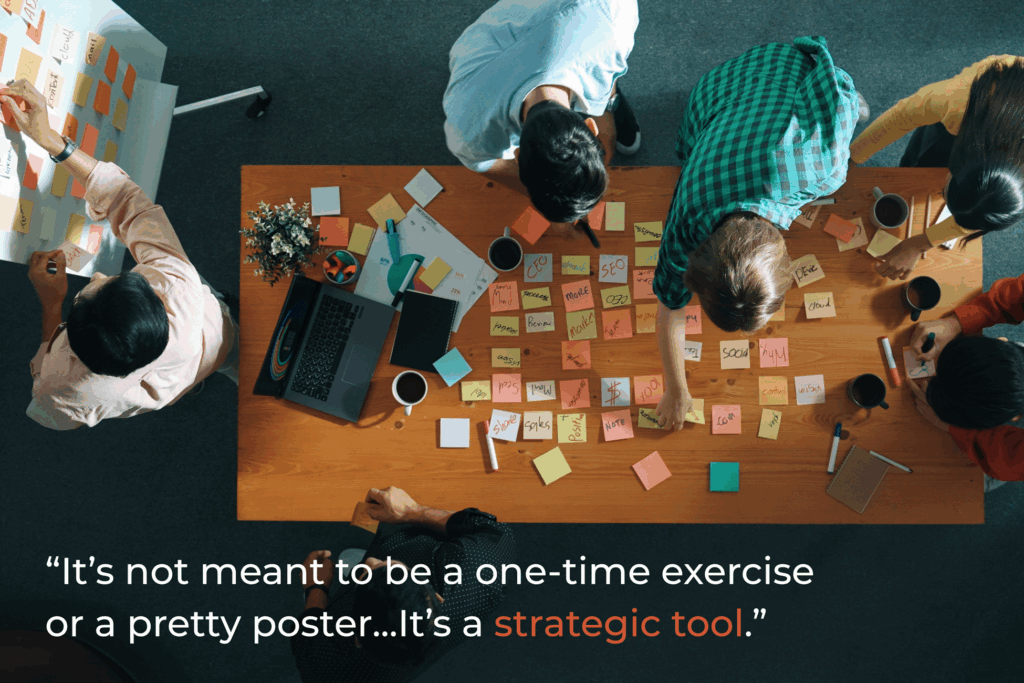by Margaret-Anne Heyland
So, you’ve built your customer journey map. The sticky notes are on the wall (or the digital board is full), the stages are clearly defined, and the customer’s pain points and opportunities are mapped out.
Now comes the most important part: what you do with it.
A journey map is not meant to be a one-time exercise or a pretty poster that hangs in a conference room. It’s a strategic tool. Its true value comes from how you activate it across your organization.

Step 1: Socialize the Journey Map
Bring your journey map out of the CX or project team bubble and share it widely. Invite marketing, product, operations, IT, and leadership into the conversation. When everyone sees the customer’s experience in one view, it creates a common language and helps break down organizational silos.
Tailor the discussion to your audience:
- Executives want to see how gaps impact business outcomes and KPIs.
- Frontline teams want to see how their day-to-day actions connect to the bigger picture.
- Cross-functional teams benefit from understanding how their work intersects with other departments and the customer experience.
Socializing the map ensures that insights aren’t siloed—they become shared knowledge that drives collective action.
Step 2: Prioritize the Pain Points
Journey maps often surface dozens of insights—but not all of them are equally critical. Prioritization is key to turning observations into action. Ask questions like:
- Which friction points generate the most customer frustration?
- Where are we losing the most revenue, loyalty, or engagement?
- Which opportunities will deliver the highest impact if addressed?
Prioritizing helps teams focus on the areas that truly matter, creating a manageable roadmap instead of an overwhelming to-do list. It also ensures that resources—time, budget, and talent—are applied where they will make the biggest difference.
Step 3: Layer in Communications, Data, and Initiatives
Journey maps are powerful on their own, but layering in additional perspectives makes them truly actionable:
- Marketing communications: Overlay emails, campaigns, and ads to see where customers are silent or overwhelmed, aligning messaging with actual needs.
- Data and analytics: Use call logs, churn metrics, surveys, and usage data to validate pain points and inform evidence-based prioritization.
- Projects and initiatives: Map current workstreams to identify duplication, gaps, and budget allocation, ensuring focus on the most critical issues.
This layered approach transforms your journey map into a living tool that aligns teams, informs decisions, and drives meaningful action.
Step 4: Build Accountability
Insights without ownership rarely translate into results. Assign clear accountability for addressing gaps, resolving pain points, or implementing improvements.
- Each pain point or opportunity should have a designated owner.
- Teams should have clear milestones and deadlines.
- Leaders should track progress and support cross-functional collaboration.
This ensures that journey mapping drives tangible outcomes rather than remaining an abstract exercise. Accountability turns insights into action.
Closing Thoughts
Creating a journey map is just the beginning. The real transformation happens when you activate it—sharing it across teams, layering in additional perspectives, prioritizing what matters most, and turning insights into action.
Done well, a journey map becomes more than a tool—it becomes the blueprint for building customer experiences that are empathetic, seamless, and growth-driving.
👉 Ready to turn your journey map into results? Contact Evolv Consulting to learn how we help organizations bring their journey maps to life.
Contact Evolv Consulting to learn how we help organizations bring their journey maps to life.
Margaret-Anne is a Delivery Manager at evolv Consulting and has over 3 decades in the Financial Services Industry. As a passionate CX Leader, she spent 20 + years at USAA and helped evolve and build award-winning experiences for Investments, Retirement and Financial Health. In previous roles she was the CX Officer at American National Bank of TX and Head of Participant Experience at MassMutual. Her passion is understanding the needs and expectations of customers and looking for opportunities to improve their experiences by incorporating technology, data, empathy and understanding emotion at every customer touchpoint.





